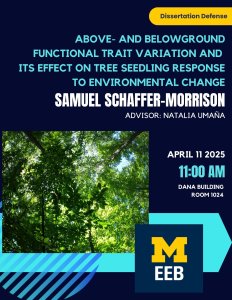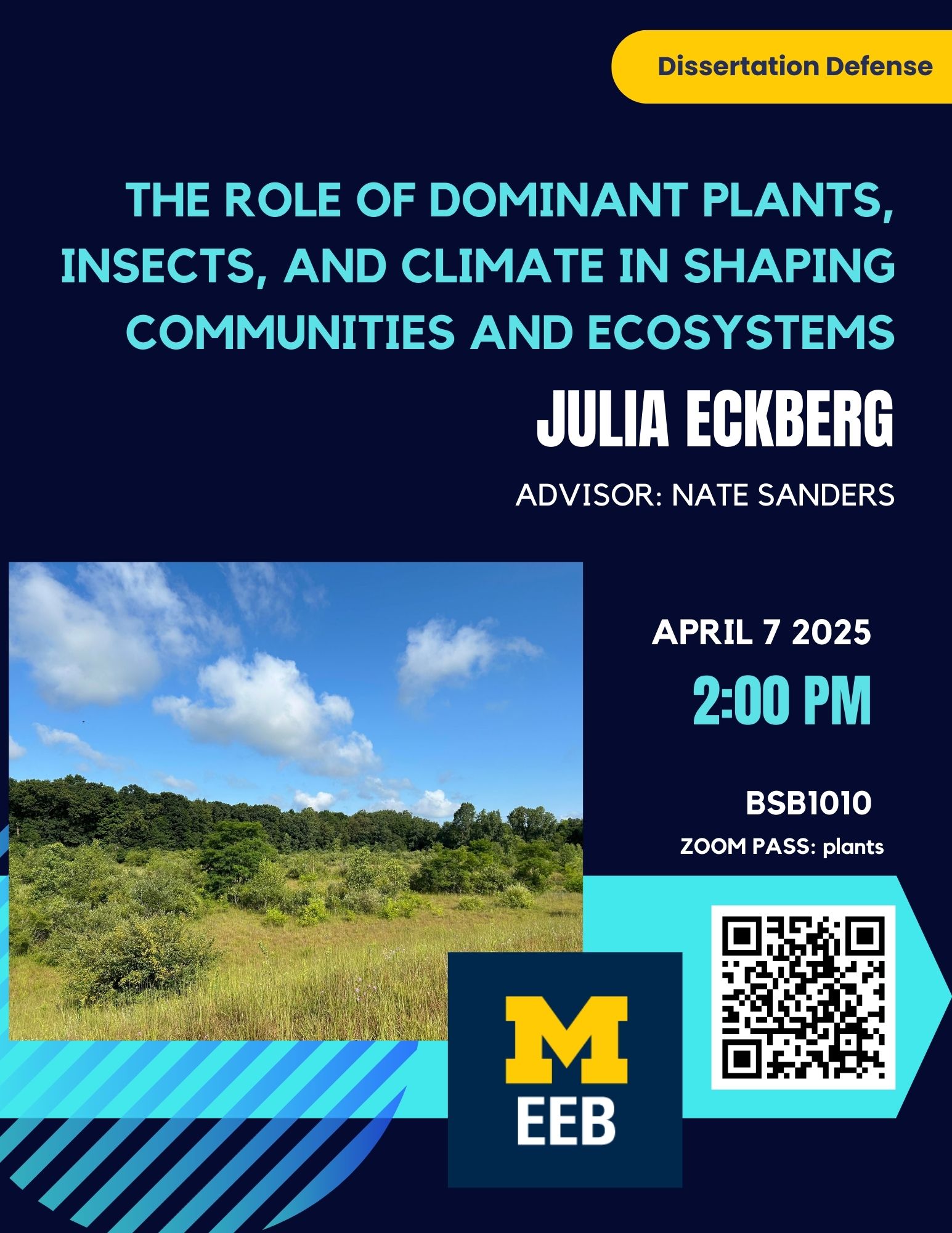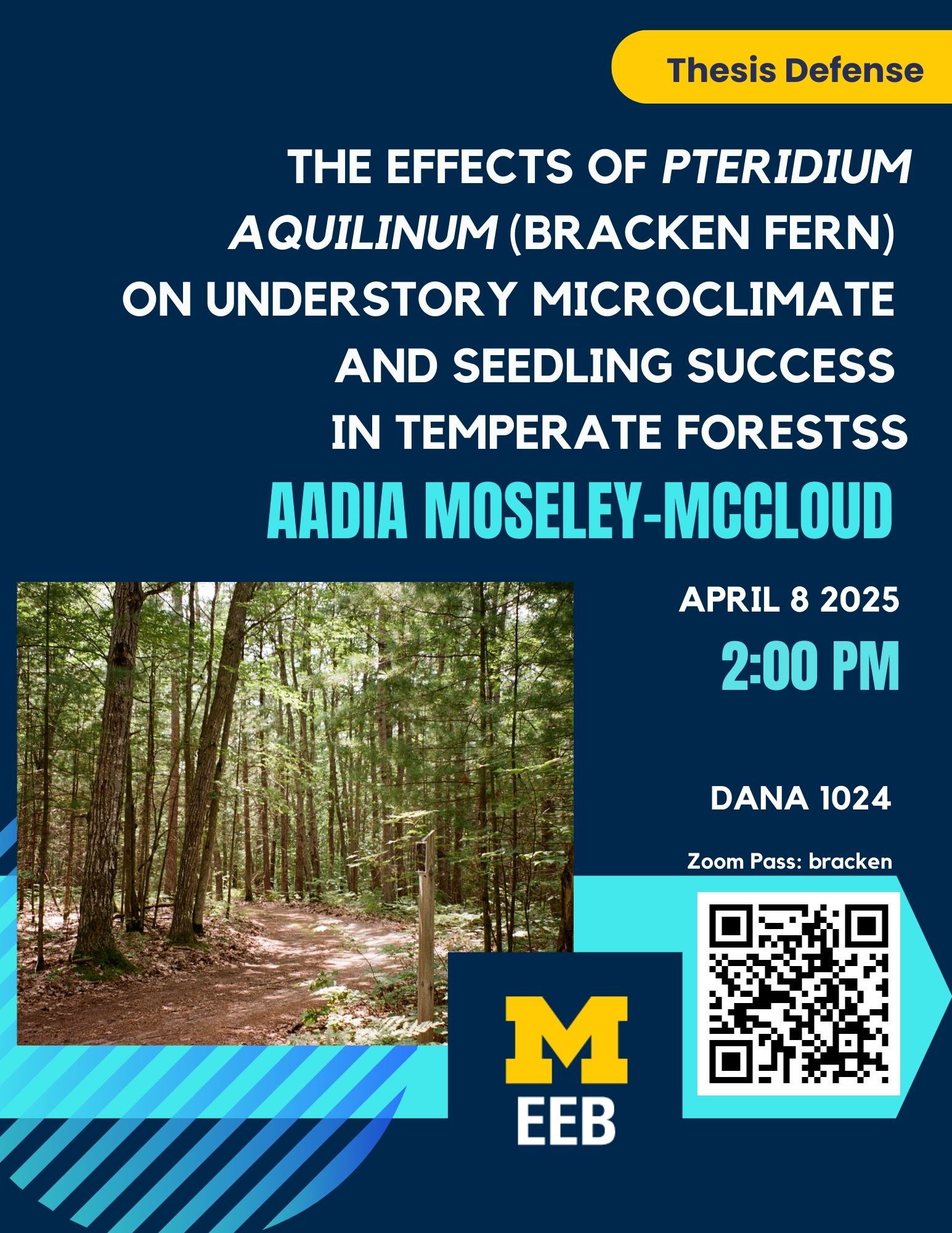Presented By: Ecology and Evolutionary Biology
EEB Student Dissertation Defense: Above- and Belowground Functional Trait Variation and Its Effect on Tree Seedling Response to Environmental Change
Samuel Schaffer-Morrison

Dissertation Title: Above- and Belowground Functional Trait Variation and Its Effect on Tree Seedling Response to Environmental Change
Abstract: To predict forest composition and function under global change it is important to understand tree responses to environmental shifts. This is especially true for seedlings, as the seedling stage represents an important forest recruitment bottleneck. Therefore, understanding the capability of seedlings of different tree species to respond to environmental changes will provide insight into how forests may look in the future. Tree responses depend on their ecological strategies, which can be defined by the functional traits of their leaves and roots, organs responsible for resource uptake above- and belowground. Prior work at the interspecific scale suggests that traits separate into three independent axes: above- and belowground resource conservation axes describing plants resource uptake efficiency and investment in organ construction, and a belowground collaboration axis describing the degree to which plants rely on mycorrhizal fungi – key root symbionts that aid in resource capture belowground. However, no work to date has explicitly tested if the proposed collaboration axis accurately describes how plants associate with mycorrhizal fungi, and therefore the extent to which roots and their symbionts contribute to nutrient uptake within species remains largely untested. My dissertation addresses this through four chapters that systematically examine patterns of plant functional trait variation and their implications for seedlings success.
In Chapter 1, I outline the current understanding of the relationships between roots and mycorrhizal fungi in trees, proposing that because roots and mycorrhizal fungi operate together, we should examine both simultaneously to get a thorough understanding of resource acquisition strategies belowground. In Chapter 2, I examined whether the collaboration axis exists independently of the two resource conservation axes intraspecifically within seedlings of Quercus rubra, Acer rubrum, A. saccharum, and P. serotina collected across Michigan. I found that aboveground traits are independent of belowground traits, however belowground traits aligned on a single axis, further calling into question the functionality of the collaboration axis.
In Chapter 3, I examined the degree to which plant functional traits of tree seedlings vary with communities of mycorrhizal fungi across a nitrogen (N) gradient. Changes in N impact the function of plants and mycorrhizal fungi alike, though no study to date has examined both simultaneously. I collected seedlings of two different mycorrhizal types: Q. rubra (ectomycorrhizal; EcM), and A. rubrum and P. serotina (arbuscular mycorrhizal; AM). Some EcM fungi can provide access to organic N that is otherwise inaccessible to plants, providing an advantage at low N. I found that seedlings tended to be more acquisitive belowground at higher N, EcM access to organic N decreased with N, and that traits not included in the collaboration axis change with mycorrhizal function, suggesting that the proposed collaboration axis is insufficient to describe plant reliance on mycorrhizae.
In Chapter 4, I applied the trait patterns observed within species in prior chapters to see how variation in traits affects seedling growth under multiple environmental stresses. Prior work examined responses of plants to a single stress; yet stresses rarely occur alone. I grew seedlings of Q. rubra, A. rubrum, and A. saccharum in the greenhouse under three levels of water and light, measuring their growth and functional traits. I found that growth decreased under multiple stresses less than is expected based upon the reduction in growth experienced when exposed to singular stresses. Furthermore, different species had different trait strategies to cope with multiple stressors.
Abstract: To predict forest composition and function under global change it is important to understand tree responses to environmental shifts. This is especially true for seedlings, as the seedling stage represents an important forest recruitment bottleneck. Therefore, understanding the capability of seedlings of different tree species to respond to environmental changes will provide insight into how forests may look in the future. Tree responses depend on their ecological strategies, which can be defined by the functional traits of their leaves and roots, organs responsible for resource uptake above- and belowground. Prior work at the interspecific scale suggests that traits separate into three independent axes: above- and belowground resource conservation axes describing plants resource uptake efficiency and investment in organ construction, and a belowground collaboration axis describing the degree to which plants rely on mycorrhizal fungi – key root symbionts that aid in resource capture belowground. However, no work to date has explicitly tested if the proposed collaboration axis accurately describes how plants associate with mycorrhizal fungi, and therefore the extent to which roots and their symbionts contribute to nutrient uptake within species remains largely untested. My dissertation addresses this through four chapters that systematically examine patterns of plant functional trait variation and their implications for seedlings success.
In Chapter 1, I outline the current understanding of the relationships between roots and mycorrhizal fungi in trees, proposing that because roots and mycorrhizal fungi operate together, we should examine both simultaneously to get a thorough understanding of resource acquisition strategies belowground. In Chapter 2, I examined whether the collaboration axis exists independently of the two resource conservation axes intraspecifically within seedlings of Quercus rubra, Acer rubrum, A. saccharum, and P. serotina collected across Michigan. I found that aboveground traits are independent of belowground traits, however belowground traits aligned on a single axis, further calling into question the functionality of the collaboration axis.
In Chapter 3, I examined the degree to which plant functional traits of tree seedlings vary with communities of mycorrhizal fungi across a nitrogen (N) gradient. Changes in N impact the function of plants and mycorrhizal fungi alike, though no study to date has examined both simultaneously. I collected seedlings of two different mycorrhizal types: Q. rubra (ectomycorrhizal; EcM), and A. rubrum and P. serotina (arbuscular mycorrhizal; AM). Some EcM fungi can provide access to organic N that is otherwise inaccessible to plants, providing an advantage at low N. I found that seedlings tended to be more acquisitive belowground at higher N, EcM access to organic N decreased with N, and that traits not included in the collaboration axis change with mycorrhizal function, suggesting that the proposed collaboration axis is insufficient to describe plant reliance on mycorrhizae.
In Chapter 4, I applied the trait patterns observed within species in prior chapters to see how variation in traits affects seedling growth under multiple environmental stresses. Prior work examined responses of plants to a single stress; yet stresses rarely occur alone. I grew seedlings of Q. rubra, A. rubrum, and A. saccharum in the greenhouse under three levels of water and light, measuring their growth and functional traits. I found that growth decreased under multiple stresses less than is expected based upon the reduction in growth experienced when exposed to singular stresses. Furthermore, different species had different trait strategies to cope with multiple stressors.



